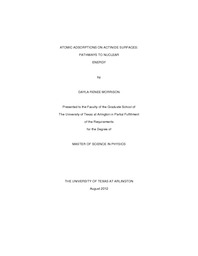
ATTENTION: The works hosted here are being migrated to a new repository that will consolidate resources, improve discoverability, and better show UTA's research impact on the global community. We will update authors as the migration progresses. Please see MavMatrix for more information.
Show simple item record
| dc.contributor.author | Morrison, Dayla Renee | en_US |
| dc.date.accessioned | 2013-03-20T19:10:38Z | |
| dc.date.available | 2013-03-20T19:10:38Z | |
| dc.date.issued | 2013-03-20 | |
| dc.date.submitted | January 2012 | en_US |
| dc.identifier.other | DISS-11818 | en_US |
| dc.identifier.uri | http://hdl.handle.net/10106/11510 | |
| dc.description.abstract | The generalized gradient approximation (GGA) to density functional theory (DFT) and hybrid density functional theory have been used to compute the layer-by-layer properties of γ-uranium (γ-U) in the (100) symmetry. Guided by bulk results which have been analyzed at six different levels of theory, the surface calculations have been performed at the non-magnetic level including spin-orbit coupling. The ground state bulk lattice constant and bulk modulus are found to be 3.46 A and 113.75 GPa, respectively at the non-magnetic with spin-orbit coupling level (NM+SOC) of theory. The monolayer displays a significant shrinking of the “effective” lattice constant of about 23.55% from bulk theoretical values. Further analysis of the change in energy per added “bulk” indicates that after 5 layers the energy stabilizes and does not change by more than 10 mRy. The surface energy and the work function of the γ-U (100) surface are predicted to be 1.56 J/m2 and 3.24 eV respectively. Electronic density of states plots of atoms located at the surface, subsurface and center of a hexa-layer slab indicate some localization of the 5f electrons at or near the Fermi level with a gradual trend toward delocalization with increased depth within the slab. Analysis of the adsorption of a H atom on the (100) surface of a 5 layer slab of bcc γ-U indicates an exothermic reaction with the bridge site as the preferred site with a chemisorption energy of 3.80 ev at the fully relativistic level of theory. H bound to the lattice in interstitial regions was also found to be exothermic in nature, also, with the interstitial bridge site being the most stable at 2.13 ev at the nonmagnetic state with spin-orbit coupling included in the calculation. Two potential wells were found under the surface. Other properties of the H-γ-U system were calculated including the ground state magnetic configuration, change in work function, change in magnetic moment on the surface and change in charge. Similarly, the adsorption of the O atom on the (100) surface of γ-U was also analyzed. It is found to be an exothermic reaction with chemisorption energy at the most stable bridge site of 8.43 eV including SOC. The preferred magnetic ordering of the atomic spins is nonmagnetic, which does not agree with experimental findings of O adsorption on α-U, indicating the need for further study on the O-γ-u system. The O atom is not likely to diffuse into the solid due to a potential barrier very near the surface of approximately 3 eV. Interstitial binding of the O atom to the lattice is an endothermic reaction indicated by the negative chemisorption energies in those sites. Chemisorption energies at interstitial bridge site came to -0.53 eV with SOC at the nonmagnetic level of theory. | en_US |
| dc.description.sponsorship | Ray, Asok | en_US |
| dc.language.iso | en | en_US |
| dc.publisher | Physics | en_US |
| dc.title | Atomic Adsorptions On Actinide Surfaces: Pathways To Nuclear Energy | en_US |
| dc.type | M.S. | en_US |
| dc.contributor.committeeChair | Ray, Asok | en_US |
| dc.degree.department | Physics | en_US |
| dc.degree.discipline | Physics | en_US |
| dc.degree.grantor | University of Texas at Arlington | en_US |
| dc.degree.level | masters | en_US |
| dc.degree.name | M.S. | en_US |
Files in this item
- Name:
- Morrison_uta_2502M_11818.pdf
- Size:
- 5.642Mb
- Format:
- PDF
This item appears in the following Collection(s)
Show simple item record


